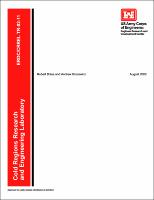Please use this identifier to cite or link to this item:
https://hdl.handle.net/11681/5395Full metadata record
| DC Field | Value | Language |
|---|---|---|
| dc.contributor.author | Bolus, Robert L. | - |
| dc.contributor.author | Bruzewicz, Andrew J. | - |
| dc.date.accessioned | 2016-03-21T16:37:05Z | - |
| dc.date.available | 2016-03-21T16:37:05Z | - |
| dc.date.issued | 2002-08 | - |
| dc.identifier.uri | http://hdl.handle.net/11681/5395 | - |
| dc.description.abstract | Large-scale natural or technological disasters often require some level of government response to mitigate their effects. U.S. Army Corps of Engineers response actions may occur under Public Law 84-99 authorizing the Chief of Engineers to activate the Corps for emergency flood control and coastal shore protection or under P.L. 93-288 as work for the Federal Emergency Management Agency (FEMA). Regardless of the type of disaster, rapid image acquisition and analysis is an important initial source of information that can detail conditions over a wide area. The time interval (a few hours to a few days) during which imagery provides added value is exceptionally limited, because once ground observations are reliably available, the imagery only provides duplicate information. Therefore, a test was developed to evaluate how quickly proxy hurricane damage imagery could be acquired with an airborne sensor and orthorectified into digital products that could be posted on an FTP site for the Corps of Engineers. Emerge, a company with sensors in the US, was tasked to acquire imagery with multiple ground sampling distances (GSDs) to determine the optimal pixel size for determining both cover on roofing and visibility of underlying rafters at new house construction sites and broad-leaf/narrow-leaf tree types in Lakeland, Florida. Emerge was also tasked to keep their response time interval within 12 hours from start of image acquisition to a finished geographic information system (GIS)-compatible product. The results were as follows: (1) Individual roof rafters were always distinguishable with 8-in. GSD and often with 1-ft GSD. (2) Wood covering vs. tarpaper and/or shingles was always visible with 1-ft and 8-in. GSD, and often with 2-ft GSD. (3) Neither spatial nor spectral analysis methods yielded tree type information, with the exception of palm trees. (4) Emerge demonstrated its capability to mount an emergency response collection from image acquisition to production of orthorectified frames within the 12-hr time frame. | - |
| dc.publisher | Cold Regions Research and Engineering Laboratory (U.S.) | - |
| dc.publisher | Engineer Research and Development Center (U.S.) | - |
| dc.relation | http://acwc.sdp.sirsi.net/client/en_US/search/asset/1001606 | - |
| dc.relation.ispartofseries | ERDC/CRREL ; TR-02-11. | - |
| dc.subject | Emergency management | - |
| dc.subject | Airborne profile recorder--Evaluation | - |
| dc.title | Evaluation of new sensors for emergency management | - |
| dc.type | Report | en_US |
| Appears in Collections: | Technical Report | |
Files in This Item:
| File | Description | Size | Format | |
|---|---|---|---|---|
| CRREL-TR-02-11.pdf | 9.33 MB | Adobe PDF |  View/Open |